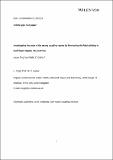Investigating the onset of the strong coupling regime by fine-tuning the Rabi splitting in multilayer organic microcavities
Abstract
Given the prevalence of disorder in many organic semiconductors, the applicability of simple models to describe their behavior in the strong coupling regime, like the two-level coupled oscillator, is not evident. Here, the validity of the two-level coupled oscillator model and the simple dependence of the coupling strength on the number of absorbers and the electric field is tested experimentally in metal-clad microcavities containing a disordered film of small molecules. Multi-layer microcavities are produced by combining different thin film deposition techniques. These allow for isolating the relevant parameters and thus to confirm the coupling strength is proportional to (1) the square root of the number of absorbers and (2) the amplitude of the electric field. By changing either of these two parameters, the microcavities are shifted from the weak to the strong coupling regime. Moreover, careful analysis reveals that there is a threshold coupling strength for the onset of the Rabi splitting. Two independent investigations show that this threshold is comparable to the losses in the cavities. These results validate the coupled two-level Hamiltonian for microcavities containing disordered organic semiconductors, even though the assumption of a single exciton level represents a strong simplification for these systems.
Citation
Tropf , L & Gather , M C 2018 , ' Investigating the onset of the strong coupling regime by fine-tuning the Rabi splitting in multilayer organic microcavities ' , Advanced Optical Materials , vol. Early View , 1800203 . https://doi.org/10.1002/adom.201800203
Publication
Advanced Optical Materials
Status
Peer reviewed
ISSN
2195-1071Type
Journal article
Description
This research was financially supported by the European Research Council under the European Union’s Horizon 2020 Framework Programme (FP/2014-2020)/ERC Grant Agreement No. 640012 (ABLASE), the Volkswagen Foundation (93404), and the Scottish Funding Council (through SUPA). L.T. acknowledges the studentship funding through the EPSRC CM-CDT (EP/L015110/1).Collections
Items in the St Andrews Research Repository are protected by copyright, with all rights reserved, unless otherwise indicated.

